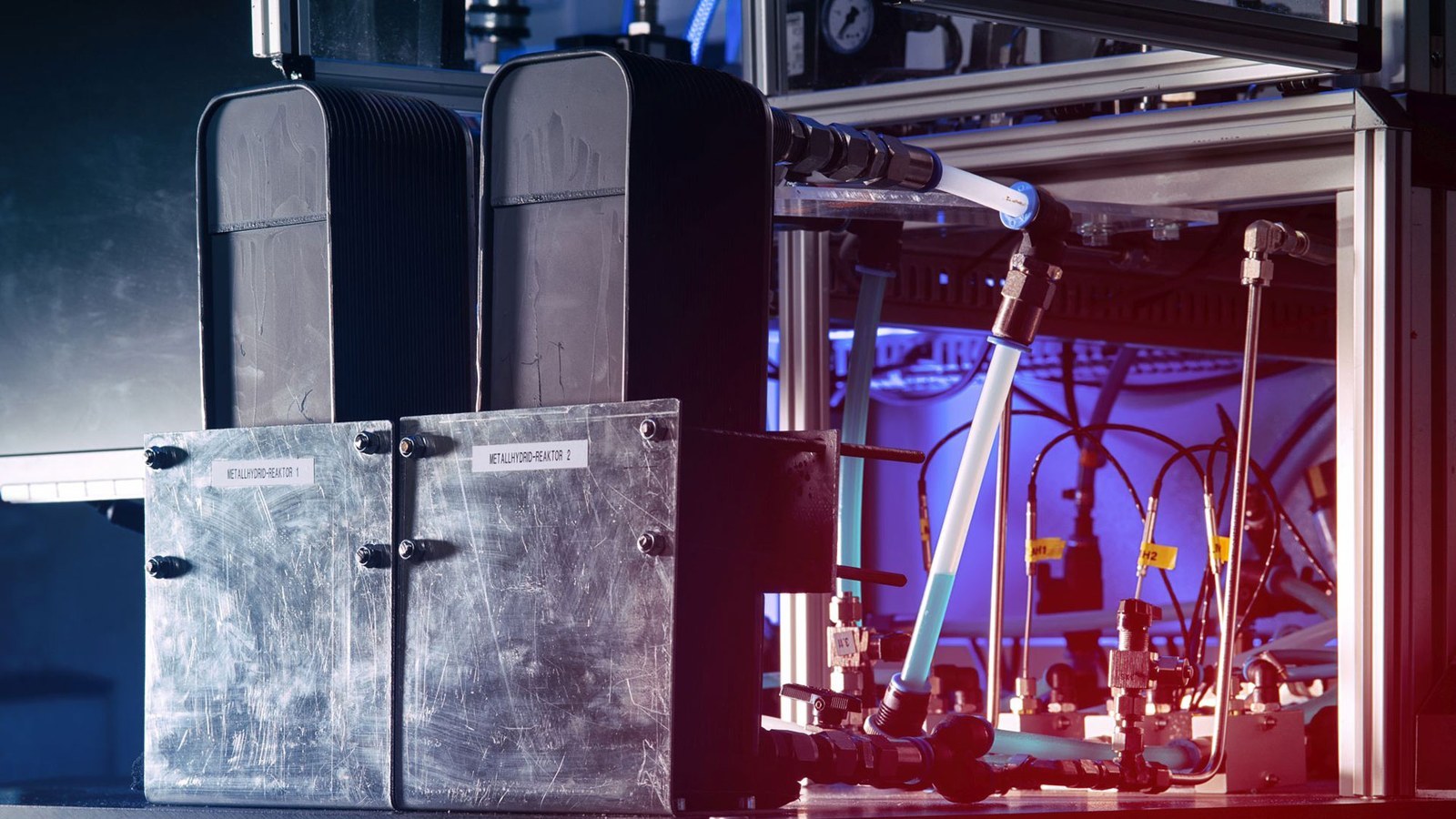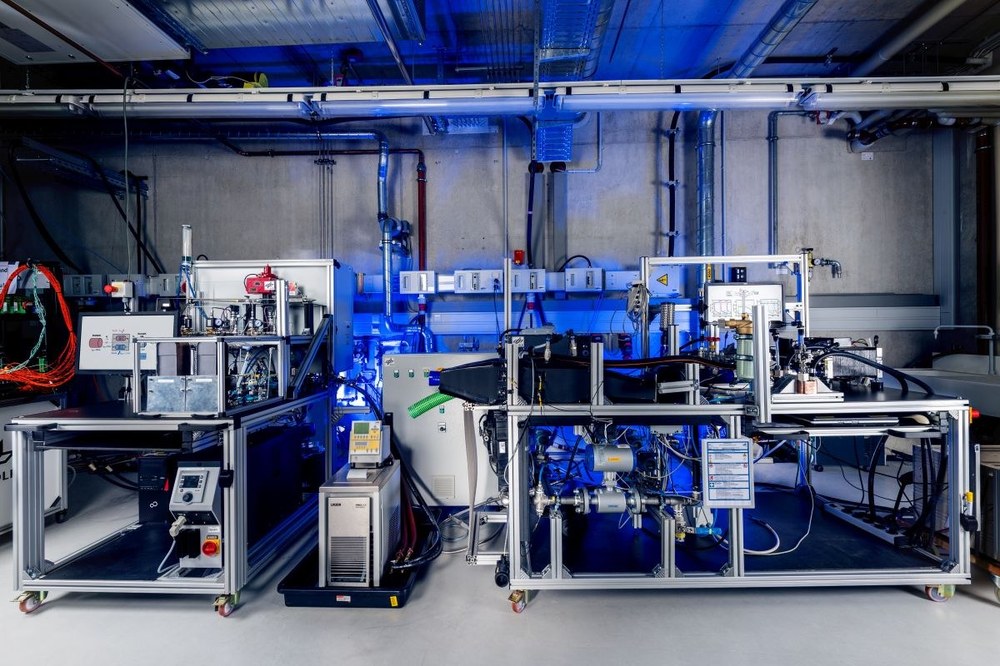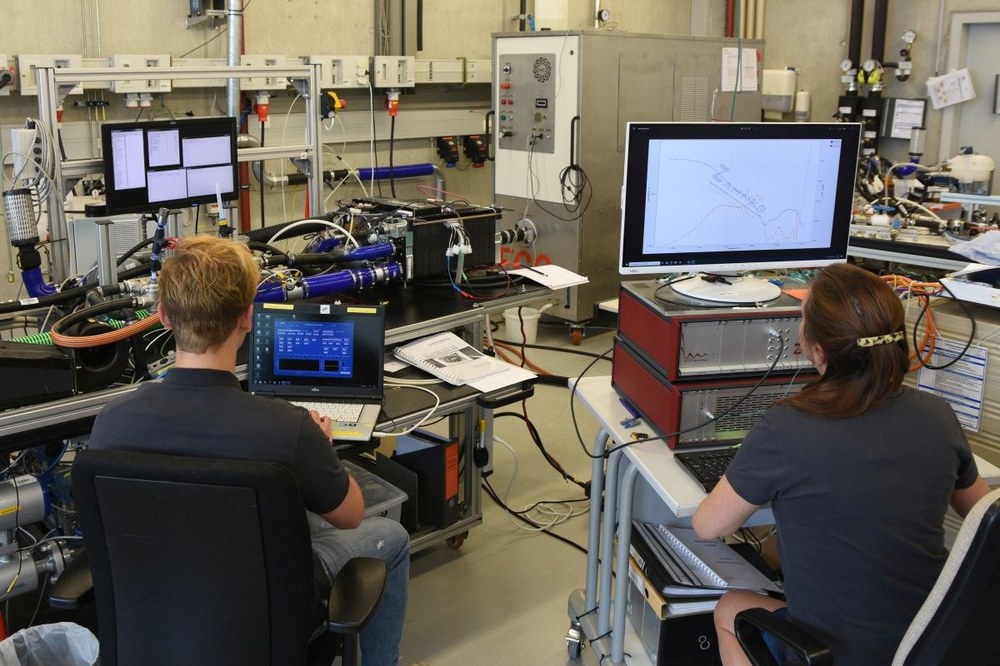Hydrogen and fuel cells
Power | |
|---|---|
Stacks | Tests up to approx. 80 kW possible |
Fuel cell systems | up to 30 kW |
Air supply | up to 60 kW |
Combination Kaeser compressor + domestic supply H2 supply for approx. 60 kW | Supply from H2 bundle station |
Kaeser compressor characteristics | |
Operating pressure | 7.5 bar |
Max. delivery quantity | 1.859 m³/min (= 40 g/s) |
Voltage | up to 400 V (0.2 %, 0.01 %) |
Current | 0-400 A (0.2 %, 0.01 %) |
Blower characteristics | |
Operating pressure | 1.2 bar |
Max. delivery quantity | 2,500 l/min |
Measuring equipment - dynamics and measuring accuracy | |
100 measuring channels | 21 bit, 0.01 %, potential separation 650/750 V |
5 Coriolis flow sensors | Liquid 0.1 %, gases 0.5 % for water, hydrogen and air |
8 Differential pressure sensors | in the range from 0.01 to 4 bar (0.065 %) |
Single cell voltage measurement | for 240 (600) cells (0.1 %, time < 1 ms/cell, isol. 1 kV) |
Pressure sensors | 0 - 6 bar, 0.5 % |
Temperature sensors | Class A, 0.15°C |
4 sensors for relative humidity | 0 - 100 % rH, 0.5+1.5 % from measured value, up to 100 °C) |
Conductivity | 0.001 - 200 μs/cm, 0.5 % |
Other | Highly dynamic media supply (fast hydraulic valves, 0 - 100 % - 1 s) |
Power | |
|---|---|
Fuel cell systems | up to 30 kW |
Air supply | currently for approx. 30 kW |
CompAir compressor or blower | |
H2 supply | currently for approx. 60 kW Supply from H2 bundle station |
CompAir compressor characteristics | |
Operating pressure | 7.5 bar |
Max. delivery quantity | 13.98 m³/min |
Blower characteristics | |
Operating pressure | 1.2 bar |
Max. delivery quantity | 2,500 l/min |
Voltage | up to 650 V (0.2 %, 0.01 %) |
Current | 0 - 400 A (0.2 %, 0.01 %) |
Measuring equipment - dynamics and measuring accuracy | |
100 measuring channels | 21 bit, 0.01 %, potential separation 650/750 V |
5 Coriolis flow sensors | Liquid 0.1 %, gases 0.5 % for water, hydrogen and air |
8 Differential pressure sensors | in the range from 0.01 to 4 bar (0.065 %) |
Single cell voltage measurement | for 240 (600) cells (0.1 %, time <1 ms/cell, isol. 1 kV) |
Impedance spectroscopy (single cells and systems up to 100 V and 400 A) | 10 µHz- 2 MHz, ±5 V-±15 V, AC amplitude 0 - 6 V or 0 - 2 A |
Pressure sensors | 0 – 6 bar, 0.5 % |
Temperature sensors | Class A, 0.15 °C |
4 sensors for relative humidity | 0 – 100 % rH, 0.5+1.5 % from measured value, up to 100 °C |
Conductivity | 0.001 - 200 μs/cm, 0.5 % |
Other | |
Highly dynamic media supply (fast hydraulic valves, 0 - 100 % - 1 s) | |
Cyclovoltammetry | |
U-I characteristic curves |
Power | |
|---|---|
Stacks | 12 kW |
Air supply | currently for approx. 30 kW |
CompAir compressor | |
H2-Supply | for approx. 60 kW Supply from H2-bundle station |
Coolant supply | 20–90 °C, 60 l/min |
CompAir compressor characteristics | |
Operating pressure | 7.5 bar |
Max. delivery quantity | 13.98 m³ /min |
Characteristics of the air conditioning system | |
Operating pressure | 4 bar |
Max. delivery quantity | 2.333 m³ /min |
Temperature range | 5–90 °C |
Humidity | 20–85 % |
Voltage | bis 400 V (0.2 %, 0.01%) |
Current | 0–650 A (0.2 %, 0.01 %) |
Measuring equipment - dynamics and measuring accuracy | |
100 measuring channels | 21 bit, 0.01 %, potential separation 650/750 V |
5 Coriolis flow sensors | Liquid 0.1 %, gases 0.5 % for water, hydrogen and air |
8 differential pressure sensors | in the range from 0.01 to 4 bar (0.065 %) |
Single cell voltage measurement | for 240 (600) cells (0.1 %, time <1 ms/cell, isol. 1 kV) |
Impedance spectroscopy (single cells and systems up to 100 V and 400 A) | 10 µHz- 2 MHz, ±5 V-±15 V, AC amplitude 0 - 6 V or 0 - 2 A |
Pressure sensors | 0 - 6 bar, 0.5 % |
Temperature sensors | Class A, 0.15 °C |
4 sensors for relative humidity | 0 - 100 % rH, 0.5+1.5 % from measured value, up to 100 °C |
Conductivity | 0.001 – 200 μs/cm, 0.5 % |
Other | |
Highly dynamic media supply (fast hydraulic valves, 0 - 100 % - 1 s) | |
Cyclovoltammetry | |
U-I characteristic curves |
Brand | Zahner |
Frequency range | 10 µHz to 12 MHz |
Resolution | 32 bit DC and 24 bit AC |
AC Ampl. | 0 - 6 V for EIS |
Impedance range | 0 - 10 MOhm |
Internal potentiostat | 12 V, 1 A, 12 W |
Electrical load | 1000 W, 200 A expandable to 600 A with external load, ± 4 V expandable to ± 100 V |
Power Multiplexer | 17 channels |
4 quadrant power potentiostat | ±40 A, ±20 V |
Electrochemical measurement methods | Electrochemical impedance spectroscopy, current-voltage curves, linear sweep voltammetry, cyclic voltammetry, battery cyclisation, AC-DC-AC test procedures |



